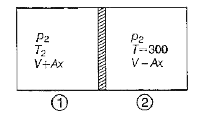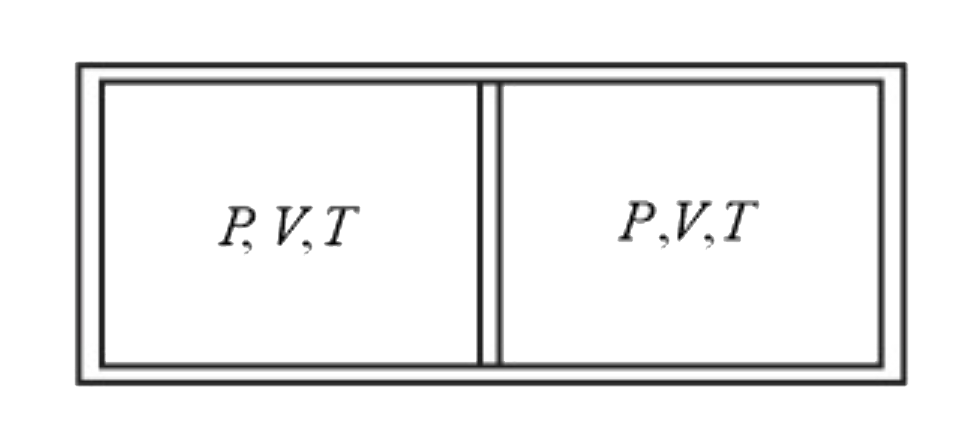A cylinder closed at both ends is separated into two equal parts (45cm each) by a piston impermeable to heat. Both the parts contain the same masses of gas at a temperature of 300K and a pressure of 1atm. How much the gas should be heated in one part of the cylinder to shift the piston by 5cm and the pressure of the gas after shifting the piston?
T=365K and P=1.125 atm
T=350K and P=1.125atm
T=375K and P=2.125 atm
T=375K and P= 1.125atm
The correct Answer is:D
Let the crossectional area of the cylinder is A. Initially

Representing a closed cylinder separated by a piston

Piston is shifted by 5cm in the cylinder
For 1,P1V1T1=p2V2T2⇒pV300=p2(V+Ax)T2 ...(i)
For 2,p1V1=p2V2⇒pV=p2(V−Ax)
p2=pV(V−Ax) ...(ii)
From Eqs. (i) and (ii), pV300=pV(V−Ax)(V+Ax)T2
⇒T2=V+AxV−Ax300=A45+AsA45−AS×300=5040300
T2=375K
Putting T2 in Eq (i) p2=PV(V+Ax)×375300=1×A×45A(450+5)×375300
=1.125 atm
Similar Questions
A cylinder closed at both ends is separated into two equal parts (45 cm each) by a piston impermeable to heat. Both the parts contain the same masses of gas at a temperature of 300 K and a pressure of 1 atm. If now the gas in one of parts is heated such that the piston shifts by 5 cm, then the temperature and the pressure of the gas in this part after heating is
View SolutionA horizontally kept cylindrical vessel closed at both ends is separated into two equal (42 cm each) parts by an adiabatic piston. Both parts contain gas having equal mass at a temperature of 27∘C and a pressure of 1 atm. How much should the gas be heated in one part of the cylinder to shift the piston by 2 cm? Find the pressure p of the gas after shifting of the piston.
View Solution
Knowledge Check
A cylinder closed at both ends is separated into two equal parts (45 cm each) by a piston impermeable to heat. Both the parts contain the same masses of gas at a temperature of 300 K and a pressure of 1 atm. If now the gas in one of parts is heated such that the piston shifts by 5 cm, then the temperature and the pressure of the gas in this part after heating is
AT = 365 K and P = 1.125 atmBT = 350 K and P = 1.125 atmCT= 375 K and P = 2.125 atmDT = 375 K and P = 1.125 atm
A vertical cylinder closed at both ends is divided into two parts by a frictionless piston, each part containing one mole of air. At 300K the volume of the upper part is 4 times of the lower part. At what temperature will the volume of the upper part be three times that of the lower part?
View SolutionA vertical cylinder closed at both ends is divided into two parts by a frictionless piston, each part containing one mole of air. At 300K the volume of the upper part is 4 times of the lower part. At what temperature will the volume of the upper part be three times that of the lower part?
View SolutionA piston can freely move inside a horizontal cylinder closed from both ends. Initially, the piston separates the inside space of the cylinder into two equal parts each of volume V0 in which an ideal gas is contained under the same pressure p0 and at the same temperature. What work has to be performed in order to increase isothermally the volume of one part of gas η times compared to that of the other by slowly moving the piston ?
View SolutionA piston can freely move inside a horizontal cylinder closed from both ends. Initially, the piston separates the inside space of the cylinder into two equal parts each of volmek V0 in which an ideal gas is contained under the same pressure p0 and at the same temperature. What work has to be performed in order to increase isothermally the volume of one part of gas η times compared to that of the other by slowly moving the piston ?
View SolutionThe pressure of a gas contained in a cylinder with a movable piston is 300 Pa. The area of the piston is 0.5m2. Calculate the force that is exerted on the piston.
View Solution(i) A conducting piston divides a closed thermally insulated cylinder into two equal parts. The piston can slide inside the cylinder without friction. The two parts of the cylinder contain equal number of moles of an ideal gas at temperature T0. An external agent slowly moves the piston so as to increase the volume of one part and decrease that of the other. Write the gas temperature as a function of ratio (β) of the volumes of the larger and the smaller parts. The adiabatic exponent of the gas is γ.
(ii) In a closed container of volume V there is a mixture of oxygen and helium gases. The total mass of gas in the container is m gram. When Q amount of heat is added to the gas mixture its temperature rises by ΔT. Calculate change in pressure of the gas.
View SolutionA cylindrical vessel made of thermally insulating material is divided into two equal parts by an insulating and. Movable piston. Both parts contain ideal monoatomic gas . The gas in the left part is supplied heat such that the volume of right part becomes one-eight of its initial volume . Work done by the gas in the right part is

View Solution
